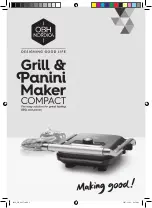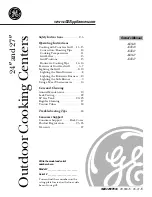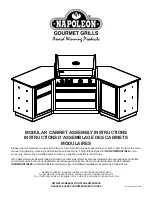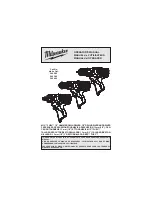
10
ENGLISH (
Original Instructions)
WARNING: Do not attempt to tighten drill bits (or
any other accessory) by gripping the front part of
the chuck and turning the tool on. Damage to the
chuck and personal injury may result. Always lock
off trigger switch when changing acces sories.
Be sure to tighten chuck with one hand on the chuck sleeve
and one hand holding the tool for maximum tightness.
Chuck removal (Fig F)
Turn the adjustment collar to the “drill” position and gear
shifter to position 1 (low speed). Tighten the chuck around
the shorter end of a hex key (not supplied) of 6.35 mm (1/4”)
or greater size. Using a wooden mallet or similar object,
strike the longer end in the clockwise direction, as shown.
This will loosen the screw inside the chuck.
Open chuck jaws fully, insert screwdriver (or Torx tool if
required) into front of chuck between jaws to engage screw
head. Remove screw by turning clockwise (left-hand-
thread). Place hex key in chuck and tighten, as shown in
Figure F. Using a wooden mallet or similar object, strike key
sharply in the counterclockwise direction. This will loosen
the chuck so that it can be unscrewed by hand.
Chuck installation (Fig G)
Screw the chuck on by hand as far as it will go and insert
screw (left-hand thread). Tighten screw securely. Tighten the
chuck around the shorter end of a 6.35 mm (1/4”) or larger
hex key (not supplied) strike the longer end in the clockwise
direction with a wooden mallet, as shown. Tighten the screw
once again by turning in a counterclockwise direction.
Drill operation
WARNING: To reduce the risk of serious personal
injury, turn tool off and disconnect tool from
power source before making any adjustments or
removing/installing attachments or accessories.
WARNING: To reduce the risk of personal
injury, ALWAYS ensure workpiece is anchored
or clamped firmly. If drilling thin material, use a
wood “back-up” block to prevent damage to the
material.
Turn the collar to the drill bit symbol for drilling. Select the
desired speed/torque range using the gear shifter to match
the speed and torque to the planned operation.
1 Use sharp drill bits only. For WOOD, use twist drill bits,
spade bits, or hole saws. For METAL, use high-speed
steel (HHS) twist drill bits or hole saws.
2 Always apply pressure in a straight line with the bit. Use
enough pressure to keep drill biting, but do not push
hard enough to stall the motor or deflect the bit.
3 Hold tool firmly with both hands to control the twisting
action of the drill.
WARNING: The drill may stall if overloaded
causing a sudden twist. Always expect the stall.
Grip the drill firmly with both hands to control the
twisting action and avoid injury.
4 IF DRILL STALLS, it is usually because it is being
overloaded or improperly used. RELEASE TRIGGER
IMMEDIATELY, remove drill bit from work, and
determine cause of stalling. DO NOT CLICK TRIGGER
ON AND OFF IN AN ATTEMPT TO START A STALLED
DRILL — THIS CAN DAMAGE THE DRILL.
5 To minimize stalling or breaking through the material,
reduce pressure on drill and ease the bit through
the last fractional part of the hole.6•
Keep the
motor running when pulling the bit back out of a drilled
hole. This will help prevent jamming.
6 With variable speed drills there is no need to center
punch the point to be drilled. Use a slow speed to start
the hole and accelerate by squeezing the trigger harder
when the hole is deep enough to drill without the bit
skipping out.
Operation as a screwdriver
Select the desired speed/torque range using the dual range
gear shifter on the top of tool to match the speed and
torque to the planned operation. Insert the desired fastener
accessory into the chuck as you would any drill bit. Make a
few practice runs in scrap or unseen areas to determine the
proper position of the clutch collar.
Maximum recommended capacities
Low Range–1
Low Range–2
Bits, Metal,
Drilling
6.00 mm
3.00 mm
Wood, Flat,
Boring
19.00 mm
12.00 mm
Hole Saws
19.00 mm
16.00 mm
MAINTENANCE
Your STANLEY power tool has been designed to operate
over a long period of time with a minimum of maintenance.
Continuous satisfactory operation depends upon proper
tool care and regular cleaning.
WARNING: To reduce the risk of serious personal
injury, place the forward/reverse button in the
lockoff position or turn tool off and disconnect
battery pack before making any adjustments or
removing/installing attachments or accessories.
An accidental start-up can cause injury.
The charger and battery pack are not serviceable. There
are no serviceable parts inside.
Lubrication
Your power tool requires no additional lubrication.
Cleaning
WARNING: Blow dirt and dust out of the main
housing with dry air as often as dirt is seen
collecting in and around the air vents. Wear
approved eye protection and approved dust
mask when performing this procedure.
WARNING: Never use solvents or other harsh
chemicals for cleaning the non-metallic parts
of the tool. These chemicals may weaken the
materials used in these parts. Use a cloth
dampened only with water and mild soap. Never
let any liquid get inside the tool; never immerse
any part of the tool into a liquid.
Charger cleaning instructions
Содержание SCD121
Страница 1: ...SCD121 English Page 04 French Page 13...
Страница 2: ...2 ENGLISH Original Instructions A B 9 1 2 8 5 3 4 6 7 7 10 SC122...
Страница 3: ...3 Original Instructions ENGLISH C D E F G H 6 7 4 3...
Страница 24: ...NA111535 11 2021...










































